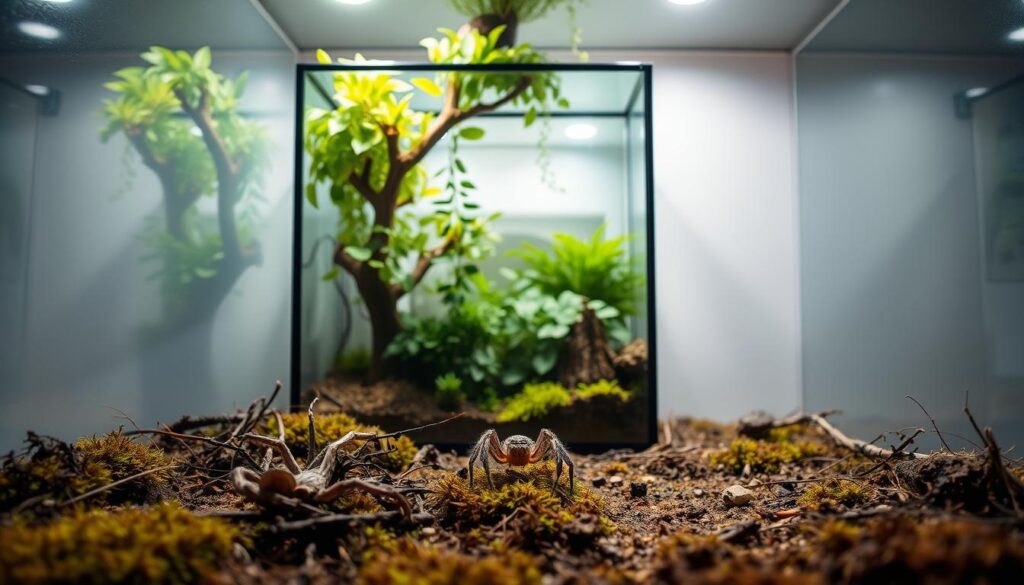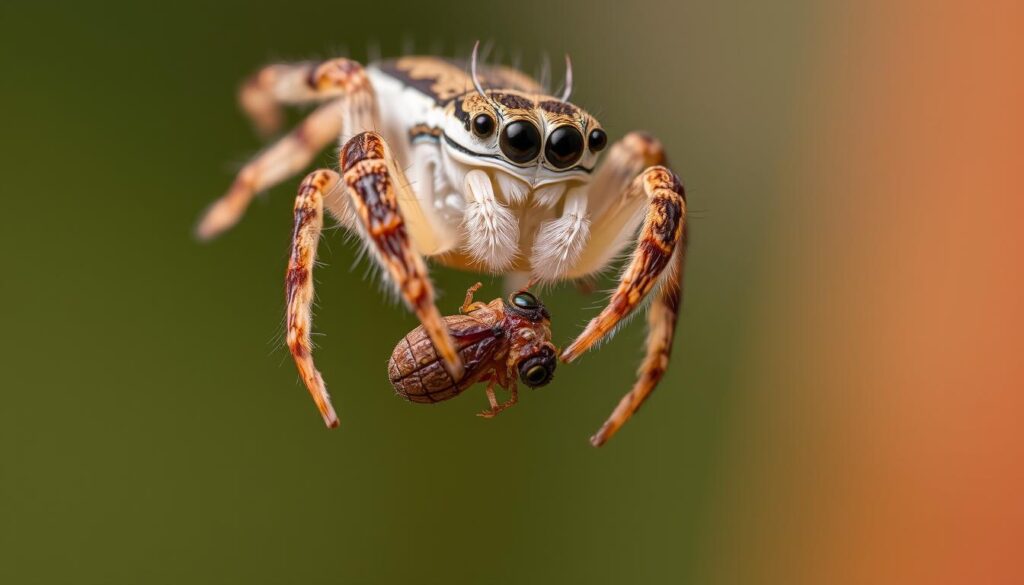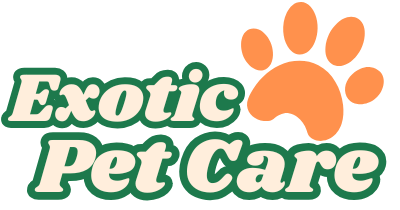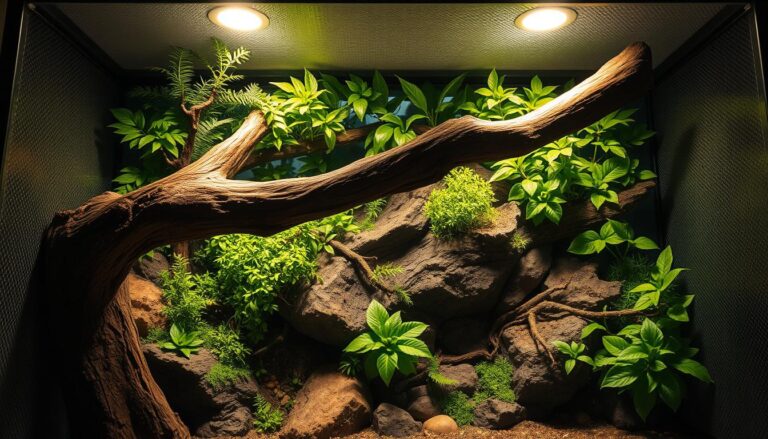Jumping Spider Enclosure Ideas: DIY Habitat and Feeding Guide
Keeping these fascinating creatures as pets has gained significant popularity in the U.S. due to their low-maintenance nature and unique behaviors. Creating a comfortable and safe environment is essential for their health and longevity.
Replicating their natural habitat is key to ensuring they thrive. This guide explores DIY solutions that combine functionality with creativity, making it easier for owners to provide the best care.
Proper feeding practices also play a crucial role in maintaining their vitality. From selecting the right food to understanding their dietary needs, this guide covers everything you need to know.
Whether you’re a new owner or an experienced enthusiast, this resource offers practical insights to help you create the perfect setup and care routine for your pet.
Key Takeaways
- These pets are gaining popularity for their low-maintenance care.
- Replicating natural habitats is vital for their health.
- DIY solutions can balance functionality and creativity.
- Proper feeding practices enhance their vitality.
- This guide is a comprehensive resource for all owners.
Essential Elements of a Jumping Spider Enclosure
Designing the perfect living space for these creatures involves understanding their specific needs. A well-planned habitat ensures their health and encourages natural behaviors. This section covers the key aspects of creating an ideal environment.
Choosing the Right Container Size and Material
The size of the container depends on the species and life stage of the pet. For most, a 1.5 to 5-gallon space is recommended. Arboreal species require vertical space to climb and explore.
When selecting materials, glass and acrylic are popular choices. Glass offers durability and clarity, while acrylic is lightweight and easier to customize. Both materials provide excellent visibility for observing your pet.

| Material | Pros | Cons |
|---|---|---|
| Glass | Durable, clear, retains heat well | Heavy, harder to modify |
| Acrylic | Lightweight, easy to customize | Scratches easily, less heat retention |
Ventilation and Humidity Control Tips
Proper airflow is crucial to prevent mold and maintain air quality. Cross-ventilation can be achieved using mesh panels or drilled holes. This ensures fresh air circulates without creating drafts.
Humidity levels should stay between 40% and 70%. Use a hygrometer to monitor moisture levels. To maintain humidity, mist the enclosure lightly or add a small water dish.
Common challenges include excessive moisture or dryness. Prevent these issues by adjusting misting frequency and ensuring proper drainage. A balanced environment keeps your pet healthy and comfortable.
Creative DIY Jumping Spider Enclosure Ideas
DIY projects offer a creative way to enhance your pet’s living space. By repurposing everyday items and incorporating natural elements, you can create a functional and visually appealing environment. Here are some innovative ideas to inspire your next project.
Upcycled Terrariums: Jars and Glass Containers
Repurposing glass containers like mason jars or pasta jars is a cost-effective and eco-friendly option. Heather Anne’s designs showcase how to modify these containers with custom mesh lids for proper ventilation. This ensures airflow while keeping your pet safe.
To create a secure lid, use fine mesh or drill small holes. Avoid sharp edges and toxic adhesives. These simple modifications can turn an ordinary jar into a cozy home for your pet.

Mini Bioactive Habitats with Live Plants
Adding live plants like peperomia and moss can create a mini bioactive habitat. These plants help maintain humidity and provide a natural aesthetic. They also encourage your pet to explore and interact with their environment.
When selecting plants, ensure they are non-toxic and easy to maintain. Combine them with substrates like coconut fiber or sphagnum moss for a realistic look. This setup mimics their natural surroundings and promotes well-being.
Themed Decorations for Stimulating Environments
Themed decorations can make the habitat more engaging. DragonGoddess69’s collection features miniature fairy garden themes with safe resin decorations like mushrooms and climbing branches. These elements add visual interest and encourage activity.
For a desert theme, use sand and small rocks. For a rainforest theme, incorporate lush plants and cork bark platforms. Always prioritize safety by avoiding sharp or toxic materials.
- Repurpose jars with custom mesh lids for ventilation.
- Use spider-safe plants like peperomia and moss.
- Add themed decorations like mushrooms and climbing branches.
- Create desert or rainforest themes for variety.
- Avoid toxic adhesives and sharp-edged materials.
These DIY ideas not only enhance your pet’s living space but also allow you to express your creativity. With careful planning, you can design a habitat that is both functional and visually stunning.
Feeding Your Jumping Spider for Optimal Health
Proper nutrition is essential for maintaining the health and vitality of your pet. Providing the right diet ensures they stay active and thrive in their environment. This section covers the best practices for feeding and hydration, helping you create a balanced routine.

Best Live Prey Options and Feeding Schedule
Flightless fruit flies are ideal for younger pets, while crickets are better suited for adults. The size of the prey should match the pet’s body to avoid overfeeding or difficulty in consumption. For juveniles, feeding 2-3 times a week is recommended, while adults only need meals once a week.
Hydration is equally important. Light misting of the habitat or using water gel crystals can help maintain moisture levels. These methods ensure your pet stays hydrated without creating excess humidity.
Common challenges include refusal to eat or overfeeding. If your pet refuses food, check for stress factors or environmental issues. Overfeeding can lead to health problems, so stick to the recommended schedule and portion sizes.
- Use flightless fruit flies for younger pets and crickets for adults.
- Feed juveniles 2-3 times a week and adults once a week.
- Match prey size to the pet’s body for safe consumption.
- Hydrate through misting or water gel crystals.
- Monitor for feeding challenges like refusal or overfeeding.
Conclusion: Building a Thriving Home for Your Pet
Creating a thriving environment for your pet requires attention to detail and thoughtful planning. Start by optimizing space, ensuring proper environmental controls, and adding enrichment elements to keep them engaged. As your pet grows, consider upgrading their habitat to meet their evolving needs.
The quality of their living space directly impacts their behavior and well-being. A well-maintained habitat encourages natural instincts and promotes a healthy lifestyle. Regular maintenance is key to sustaining this balance.
Here’s a quick checklist to help you stay on track:
Weekly Tasks: Clean surfaces, check humidity levels, and replace water.
Monthly Tasks: Inspect for wear, refresh decorations, and monitor plant health.
For advanced care tips, explore supplementary resources to deepen your knowledge and enhance your pet’s quality of life. With the right approach, you can create a home where your pet thrives.


